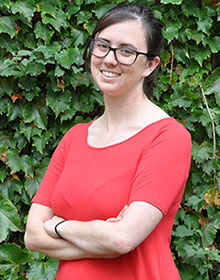Student Spotlight:
Natalia PowerS-Riggs

By Irena Garic
Where are you from, and where did you go to school as an undergraduate?
I grew up in San Francisco and moved across the country to attend to Wesleyan University where I majored in Chemistry and East Asian Studies. In between undergrad and grad school, I spent two years working as a Fellow with Teach for China, where I taught English and art to elementary and middle school students in rural China.
How did you become interested in your research?
I've always found the concept of Self-Assembly intriguing. When I came to Northwestern, I wanted to study the ordering of molecules in a different context, so jumped at the chance to make self-assembled structures and study their photophysics with spectroscopy.
Tell us about your involvement in the graduate student organizations?
I joined the board of the Association for Women in Chemistry (AWC) my second year, and we quickly rebranded as Women in Science and Engineering Research (WISER) in order to address the needs of female graduate students across STEM disciplines. I’ve been on the WISER board for 3 years, serving in a myriad of roles including treasurer and vice president. One of the events I’m proudest of is the creation of quarterly Discussion Socials, where members of all genders from the Northwestern scientific community are invited to engage in a conversation about a topic relating to gender bias in the scientific field. We’ve covered topics ranging from challenges of imposter syndrome to gendered language of recommendation letters. I’ve stepped away from the board this year, but I’m excited to see what topics get covered next!
I’ve also been involved in PLU this past year, serving as Advocacy Chair. I’ve worked to serve as a resource for student issues and provided discussions and panels to help early-career graduate students pick groups and prepare for qualifying exams.
How would you explain what you study to non-scientists?
When light hits a solar cell, an electron is dislodged, and these electrons want to be collected to create a current. My research studies that process with different models. We design and create molecules with components that absorb light and use lasers to study these processes in real time. Specifically, my project examines how to make ordered structures that absorb light in interesting ways. We’ve learned that the way molecules are positioned in relation to each other makes a big difference in the way they absorb light. I’m working to find different methods to align molecules, but since we can’t place them side by side manually, we need to create “smart” molecules that will assemble in an ordered way.
What are some potential applications for the work that you’re doing?
This work should be useful for organic solar cells. Organic solar cells (made from carbon) have high potential for cheaper, cleaner solar devices, compared to those made from crystalline silicon, but they show limited efficiency. If we can understand how light interacts with organic material, and how electrons behave in these materials, we can come up with design principles for better solar cells.
What is the best part about being in the Wasielewski Group?
The Waz group has a great balance of support and freedom to pursue your interests. It also has incredible resources- speaking to friends at other universities has made me realize that most groups specialize in either synthesizing molecules or performing spectroscopy experiments; there are few groups in the world that have the synthetic resources we do while also having multiple optical laser tables and EPR spectrometers!
What is your favorite pastime?
I’ve gotten involved in swing dancing during my time in grad school. I’ve organized lessons and live music performances on campus and go dancing in Chicago a few times a month. I’m also trying to take advantage of the Chicago theater scene and go to as many theatrical performances as I can.
